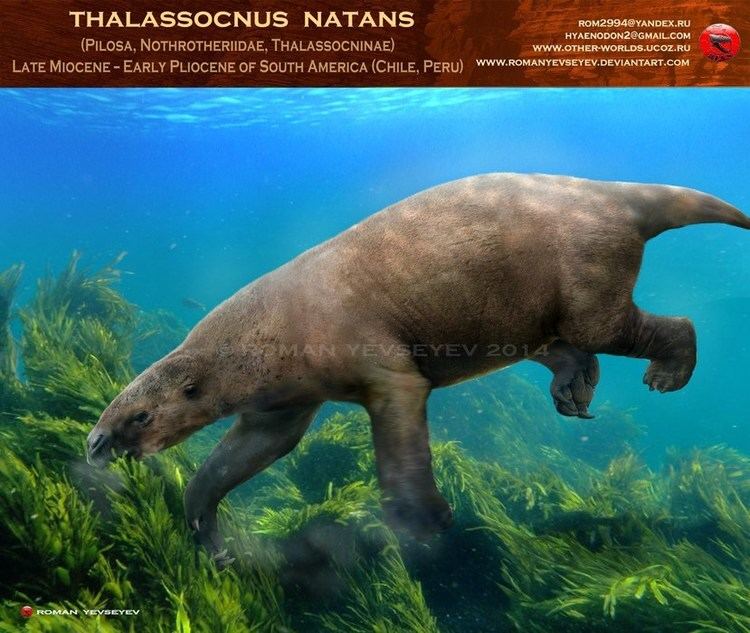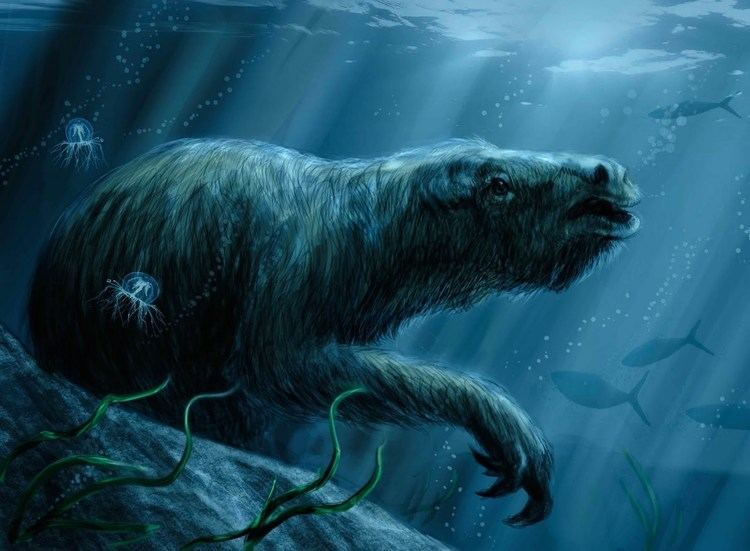Infraclass Eutheria Rank Genus | Phylum Chordata Subclass Theria Superorder Xenarthra | |
Similar Nothrotheriidae, Hapalops, Megatheriidae, Nothrotheriops, Mylodontidae | ||
Prehistoric marine sloths thalassocnus the sloth that swam
Thalassocnus is an extinct genus of apparently semiaquatic (for the geologically oldest species) or fully aquatic (for the geologically most recent species) marine sloth from the Miocene and Pliocene of South America. Fossils found to date have been from the coast of Peru and Chile. They were apparently grazers of sea grass and seaweed. The various species of this genus provides the best-documented case of gradual adaptation to a secondarily aquatic lifestyle. This is documented both at the morphological level, such as a progressive flattening of the radius, and at the microanatomical level, which shows a progressive increase in thickness (pachyostosis) and compactness (osteosclerosis) of the long limb bones and ribs, providing ballast. They may have used their powerful claws to anchor themselves to the sea floor to facilitate feeding, similar to the behavior of the marine iguana.
Contents
- Prehistoric marine sloths thalassocnus the sloth that swam
- Paleo speedsketching test 31 thalassocnus
- Description
- Taxonomy
- Nutrition
- Movement and adaptation to aquatic life
- Extinction
- Distribution and habitat
- References

Paleo speedsketching test 31 thalassocnus
Description
Thalassocnine were (semi-) marine sloths that grew to be slightly larger than the average human. The first finding of a Thalassocnus fossil was in Peru, at the Pisco Formation site. It was also here where the different species of Thalassocnus were identified. As time passed, a gradual thickening of the cortical bone was found in the ribs and limbs of Thalassocnine; an increase in density that helped to counteract the natural buoyancy of an air-breathing mammal. There is also a gentle elongation of the premaxillae and mandible symphysis, creating a long and wide snout, better adapted to munching water-weeds. The earlier species of Thalassocnine have lots and lots of striae on their weird, peg-like sloth teeth- indicating that they were taking in a lot of sand while they were feeding, probably due to wading in shallow water where any movement would stir up lots of sediment. The later species, T. carolomartini and T. yaucensis, were apparently specialized grazers that fed in deeper water; they display distinct evidence of transverse mandibular movement and lack dental striae.
Taxonomy

Presumed phylogeny of Thalassocnus, with relationship to several nothrotheriines and a megatheriid. However, a later phylogenetic study conducted by Amson, de Muizon & Gaudin (2016) indicated that Thalassocnus was not a nothrotheriid but rather a member of the family Megatheriidae.
Nutrition

Thalassocnus were herbivores, as evidenced from both osteological findings and coprolite findings from the related extinct terrestrial sloth Nothrotheriops. The tooth structure of the three early Thalassocnus species, T. antiquus, T. natans, and T. littoralis, is very similar to the type seen in Megatheria, with the molars being of the bilophodont type. This indicates that Megatheria and early thalassocninae had similar diets. Nothrotheriops are closely related to Thalassocnine. Their diet is known to have been herbivorous, as found from their faeces, preserved in the form of coprolites [I]. The foraging behaviour of the older representatives are thought to have involved the gathering of sea grasses and seaweed from shallow coastal waters, whose depth was less than one meter. Because of the plentiful striae on their teeth, the species possibly ingested sand along with their food. The younger species, T. carolomartini and T. yaucensis, do not possess these signs of sand-induced wear on the teeth. This corresponds with osteological findings, which indicate that these younger representatives were better adapted to aquatic life than their predecessors. They possibly foraged in deeper waters, in a similar manner to today's manatees. Further changes to the skull structure as the species developed also show a change in adaptation to different food sources in the younger species, from terrestrial to aquatic.
Movement and adaptation to aquatic life
Thalassocnine possessed adaptations to aquatic life, analogues of which can be found in many vertebrates that adapted to a return to living in the sea. One such adaptation is increased bone density. Heavier bones help lower buoyancy and thus conserve energy. The bones of Thalassocnus species are heavier than other mammals’, supporting their return to the water. The younger species show increasingly adapted bone structure; the younger species show decreasing medullary lumen diameter, with T. carolomartini almost completely losing the medulla in its bones [3]. Thalassocnine also possessed longer shinbones than their terrestrial relatives. This modification, along with strong forelimbs, must have allowed them to propel themselves with a paddling movement. Their spines also saw significant modifications. Relatively small vertebrae are found behind the head, not allowing for strong muscles to hold the head. In the water the buoyancy combats gravity already, and therefore in an aquatic lifestyle strong neck muscles are unneeded for this purpose. Even though the structure of the tail vertebrae hint at strong musculature, this is not necessarily evidence that Thalassocnine used their tails to swim. This pattern is also seen in tree-dwelling animals with strong prehensile tails. [II]
Extinction
Thalassocnus went extinct in the late Pliocene. This period was characterised by a higher temperature than today, as well as a higher sea level (see also: Pliocene). However, when the Isthmus of Panama formed, the coastal water of Peru cooled down. Thalassocnus might not have had the chance to adapt to this changing environment, since the change in climate also caused the extinction of sea-grasses and seaweeds in the area.
Distribution and habitat
Thalassocnus lived during an 8 million year period, lasting from the early late Miocene throughout the end of the Pliocene (11mya-2.5mya). The oldest species of Thalassocnus is T. antiquus, the most recent species is T. carolomartini.
All Thalassocnus fossils found to date were found on the Pacific coast of South-America, generally in the same layers as whales, dolphins and seabirds. Most Thalassocnus fossils have been found in Peru, especially in the so-called Pisco-Formation. Another site of interest is the Bahía Inglesa Formation in Chile, where the first non-Piso Thalassocnus fossil was found. Finding this fossil showed that the distribution area of Thalassocnus was 1600 km larger than originally thought. The Chilean fossil more closely resembled the older Thalassocnus species, T. antiquus and T. natans, than the more recent species.
Thalassocnus is described as having aquatic- or semiaquatic habits. Since the middle of the Miocene, what is now the coast of Peru has been mostly desert. Thalassocnus would live on land, but because of the lack of terrestrial plants, find its food in the ocean. Its diet most likely consisted of seaweeds and seagrasses. Changes in bone structure suggest that Thalassocnus used to live in a terrestrial habit and then slowly adapted to an aquatic one. For example, osteosclerosis found in Thalassocnus fossils seems to implicate that Thalassocnus not only swam, but walked as well. This trait would originate in the ancestors of Thalassocnus, the Megatheriidae, who lived on land. Further support for Thalassocnus having an aquatic habit comes from its limb bone proportions. The difference between the limb bone proportions of Thalassocnus and terrestrial sloths is significantly larger than the difference between the limb bone proportions of terrestrial and aquatic rodents. This indicates that, just like rodents, there were both terrestrial sloths and aquatic ones (Thalassocnus).
